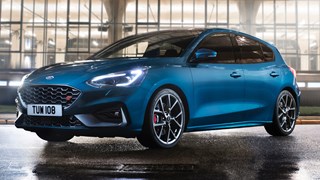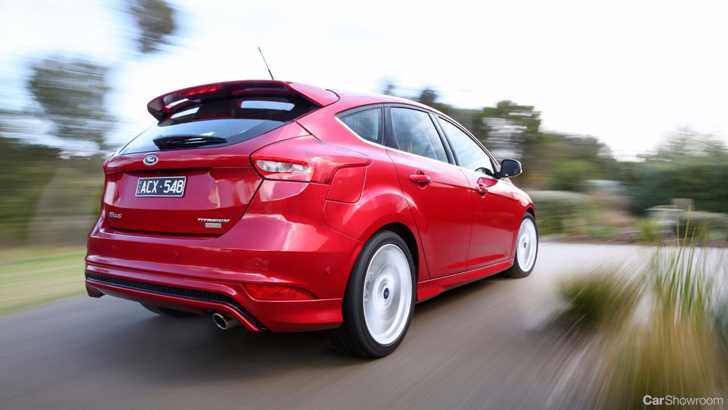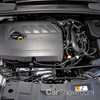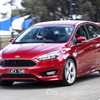The Focus has come to commandeer the specific corner of the market in which it competes. Just as the Volkswagen Golf is considered the benchmark in terms of refinement and build quality, Ford’s alternative comes across as the sportier, edgier choice.
Only recently with the emergence of strong performers such as the Hyundai i30, a renewed fight from Peugeot with the 308 and the Mazda3, competitors like the Toyota Corolla begin to look a little outclassed and certainly not as youthful.
The third-generation Focus has been in production since 2011, and this new updated version that debuted in late 2015 has brought many welcome changes that, in combination, amounts to a significant step forward. So much so, in fact, that dismissing it as merely a ‘facelift’ is an injustice.
Exterior
“The Focus was facelifted in 2014 and has a grille reminiscent of an Aston Martin. All versions get narrow headlights and a broad choice of colours, some of which are quite bold.” - Carbuyer
Over the previous pre-update third-generation Ford Focus, the exterior treatment here can actually be categorised as a facelift, contrary to what was just said. True, there have been many minor changes but these do succeed in making it distinct from the older car. And immediately too, particularly from the front where the more aggressive ST-like trapezoidal grille shape and slimmer headlights are highlighted.
That aside, there are smaller tweaks such as the new wheels that, apart from the 18-inchers in the top-spec Titanium, must be said aren’t all that exciting. And finally the smaller tail lamps that result in a dissymmetry with the fuel filler flap carried over from the 2011 original.
Ultimately, Ford got most of the original Mk III Focus right with its outside design when it debuted in 2011, and it has remained stylish enough to stand toe-to-toe and perhaps just a hair more so than its more youthful competitors in terms of sheer sporty looks after some slight tweaks. While that could be spun as a knock against Ford, really it’s a testament to the endurance of the car’s inherently strong aesthetics.
Engines and Drivetrain
“…turbo petrol engine feels a tad coarse when you give it a prod, with a note that’s more gruff than buff. Teamed with the new automatic, which can’t quite keep up with throttle inputs, it is a good rather than rousing drivetrain.” - WhichCar
Under the bonnet lies the most major change with the Focus over its immediate predecessor. The older 2.0-litre naturally aspirated Duratec petrol has been binned for a turbocharged motor that displaces 1.5-litres but through forced induction outputs more power (132kW) and torque (240Nm).
That latter metric is the root of the Focus’ improved prowess on the road, and allows drivers to surge forward on its wide band of peak twisting force (1,600rpm to 5,000rpm) where the previous atmospheric unit would be shuffling to find enough urge until later in the rev range.
It’s not the smoothest turbo-petrol in its class, though, with the Volkswagen Golf and Peugeot 308 trouncing it in settled sophistication, and this can become apparent at idle when the start-stop system hasn’t engaged or when chasing the redline to find it has simply used up its quota of boost, wherein a gruff and somewhat loud note can be heard. Mind you, the consensus is split between the engine note being interpreted as either sporty or aggravating.
This 1.5-litre EcoBoost (Ford’s zippy term for its turbocharged petrol engines) powers all Focus variants from the baseline Trend to the top-spec Titanium and is mated either to a six-speed manual or a six-speed torque converter automatic transmission that replaces the occasionally jerky and problematic dual-clutch unit used previously. And it has to be noted that, for the money, this is an impressive level of performance.
While technologically inferior a Getrag-sourced Powershift, reverting to a conventional auto box means that there’s less chance of transmission issues cropping up during the ownership experience.
Overall, the powertrain package is improved in some very obvious ways over the pre-facelift third-generation Focus, with increases in power and efficiency and even some added reliability thrown in for good measure.
Interior
“The fascia looks neater, cleaner and more contemporary as a result of the decluttering but not unquestionably classier.” - Autocar UK
Gone is button fest that plagued its predecessor, but the Focus’ interior still has some ground to gain if it intends to unseat Volkswagen as the most comprehensive all-rounder. Even against some newer entrants such as the Peugeot 308 and Mazda3, the Ford falls somewhat short in terms of sheer quality and flair.
To its credit, though, Ford has done a commendable job of sprucing up the cabin’s materials to a markedly higher level in this mid-life refresh, and the materials toward the top end of the dash do feel plush and premium. But you’ll find that the quality feel doesn’t follow you when reaching lower down, where the level of polish subsides and harder plastics abound.
That said, most buyers won’t notice this nor care about it in day-to-day ownership but instead might laud the excellent driving position, supportive seats, logically placed switchgear and decent overall ergonomics. It’s definitely a classier place to sit in than it was previously and despite some questionable material choices, there’s a pervasive sense of solidity that’s echoed in the tactility of things like buttons and air conditioning vents sliders.
Passengers in the second row do get a good amount of knee room but head room can be a problem for taller occupants due to the Focus’ more sloping roofline. There is a centre rump for the transmission tunnel, which would make sense in the all-wheel driven RS, but not so much for these regular front-driven versions.
At 316-litres for the hatch and the sedan offering 374-litres with the seats up, boot space is fair but behind class leaders and a high load lip doesn’t help, neither does the lack of helpful storage areas back there or handy anchor point ties to secure cargo.
Behind The Wheel
“It's certainly the sportiest, most enjoyable small hatch to hustle through a set of corners.” - CarsGuide
For those seeking a small hatch that drives the best, the Ford Focus is known to be the go-to choice ever since the first generation premiered in 1998. Despite some follow-ons not quite living up to that legacy, the competition hasn’t quite caught up to the Focus on the handling front.
But the race is now closer than ever, with the Ford just managing an edge lead over the dynamically talented Mazda3. Even the Volkswagen Golf has managed to become a decently involving drive in its latest MK7 generation. Peugeot’s reimagined 308 and Renault’s fourth-generation Megane is about on par as well.
However, paired with the turbocharged motor, the Focus can extract sports car levels of fun along the right sort of road, which has to be a win for what’s really a family hatchback. The sporty drive, though, doesn’t mean a compromised ride as the Focus manages to maintain a nice balance between a communicative chassis and a comfortable ride, even with the larger 18-inch alloys on the Titanium spec.
It achieves this through a more sophisticated independent rear suspension setup that helps keep the car poised even on a challenging road, a side effect of which is that it retains that level of composure when tackling bumpy town roads at lower speed.
Safety and Technology
“The big display means the Focus’s dashboard is no longer cluttered with tiny buttons, though aesthetically it looks like a fix-up job rather than a fresh coherent design…” - CarAdvice
Ford equips the Focus with a commendable list of features that should earn it some brownie points with most buyers. A particularly positive addition would be the standard 8.0-inch central infotainment screen running their SYNC3 software with audio piped through a 9-speaker Sony audio system.
This means all versions of the hatch and sedan receive support for Apple CarPlay and Android Auto in addition to the more common Bluetooth connectivity and integration with the reversing camera, another standard feature. The in-built satellite navigation system is also a welcome addition, as is the voice recognition software that’s surprisingly accurate at understanding dictation and throwing up a relevant suggestion or response.
There’s also the Active Park Assist on higher grades, a feature that does a decent job of parking the car for you once it detects a suitable space, requiring human intervention to brake and accelerate as well as shift the car between drive to reverse while it manoeuvres itself. Impressive stuff but can typically take a longer time than a competent driver would need to park in the same spot.
Along with a 5-star ANCAP safety rating, the Focus comes standard with six airbags, stability control, and hill-start assist. The top-spec Titanium is outfitted with Active City Stop (Ford lingo for autonomous emergency braking) as well as other active safety systems in addition to automatic headlamps and rain-sensing wipers. Mind you, those last two features can also be added to the base Trend variant through the optional Convenience Pack.
Verdict
The Focus of today owes a great deal to the foundation set by its predecessors, and the global success of this third-generation car is a testament to Ford’s ability to speak to buyers with a car that’s offers a sharp drive, sharp looks, and some impressive technology, wrapped in a package that represents strong value for money.
It was a compelling package when this iteration debuted in its original form in 2011, and with this update has had many of its more known foibles fixed. It now has a more intuitive laid out cabin, more powerful and efficient engines, and one of the most striking front ends in the business.
It’s the textbook example of what an updated model should be, improving on the points of friction that was exposed at launch while being careful to only build upon the same appeal that was originally present. The trouble with that is that, in key areas, these many incremental improvements hasn’t been able shoot the Focus past class leaders, but makes it a very strong performer nonetheless.
CarsGuide - 3.5/5 - “The Focus overhaul brought chiselled styling, slick infotainment and enhanced handling. All it needs now is buyer interest.”
CarAdvice - 8.5/10 - “Always a solid car, the Ford Focus now has few weaknesses and hits highs few others can boast, making it is one of the most well rounded small cars on the market.”
Autocar UK - 4/5 - “…a decent range of engines, fine practicality, striking looks and a distinguishing price are more likely to have endeared the car to the majority.”
WhichCar - 4/5 - “The Ford Focus became the most powerful mainstream small car in history in October 2015, when even the least costly models gained turbocharged engines. Every Focus also steers well, and comes with a reversing camera and satellite navigation.”
Carbuyer - 4.2/5 - “The Focus certainly deserves consideration for anyone looking for a fine-looking, great-driving car that offers plenty of equipment at a reasonable price.”







































